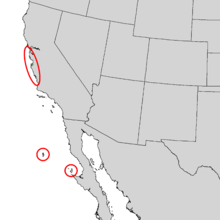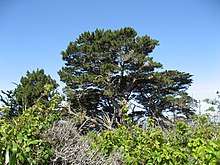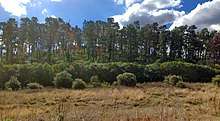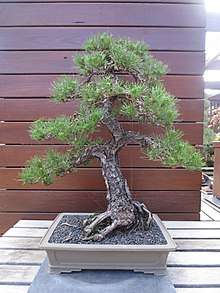Pinus radiata
Pinus radiata, family Pinaceae, the Monterey pine,[2] insignis pine[3] or radiata pine, is a species of pine native to the Central Coast of California and Mexico (Guadalupe Island and Cedros island).
| Monterey pine | |
|---|---|
| Scientific classification | |
| Kingdom: | Plantae |
| Clade: | Tracheophytes |
| Division: | Pinophyta |
| Class: | Pinopsida |
| Order: | Pinales |
| Family: | Pinaceae |
| Genus: | Pinus |
| Subgenus: | P. subg. Pinus |
| Section: | P. sect. Trifoliae |
| Subsection: | P. subsect. Australes |
| Species: | P. radiata |
| Binomial name | |
| Pinus radiata | |
 | |
| Natural range of Pinus radiata | |
P. radiata is a versatile, fast-growing, medium-density softwood, suitable for a wide range of uses.[4] Its silviculture reflects a century of research, observation and practice.[4] It is often considered a model for growers of other plantation species.[4] It is the most widely planted pine in the world, valued for rapid growth and desirable lumber and pulp qualities.
Although P. radiata is extensively cultivated as a plantation timber in many temperate parts of the world,[5] it faces serious threats in its natural range,[6] due to the introduction of pine pitch canker (Fusarium circinatum).
Distribution
It is native to three very limited areas located in Santa Cruz, Monterey Peninsula, and San Luis Obispo Counties. It is also found as the variety Pinus radiata var. binata or Guadalupe pine on Guadalupe Island, and a possibly separable P. radiata var./subsp. cedrosensis on Cedros Island, both in the Pacific Ocean off the west coast of the northern Baja California Peninsula in Mexico.
In Australia, New Zealand, and Spain it is the leading introduced tree[7] and in Argentina, Chile, Uruguay, Kenya, and South Africa it is a major plantation species. It is also an introduced tree on the world's most remote inhabited island, Tristan da Cunha.
Description
P. radiata is a coniferous evergreen tree growing to 15–30 m (50–100 ft) tall in the wild, but up to 60 m (200 ft) in cultivation in optimum conditions, with upward pointing branches and a rounded top. The leaves ("needles") are bright green, in clusters of three (two in var. binata), slender, 8–15 cm (3–6 in) long and with a blunt tip. The cones are 7–17 cm (3–6 1⁄2 in) long, brown, ovoid (egg-shaped), and usually set asymmetrically on a branch, attached at an oblique angle. The bark is fissured and dark grey to brown. When not cut short by disease or harvesting, it has a lifespan of 80 to 90 years.
It is closely related to bishop pine and knobcone pine, hybridizing readily with both species; it is distinguished from the former by needles in threes (not pairs), and from both by the cones not having a sharp spine on the scales.
The modern tree is vastly different from the native tree of Monterey.[8] In plantations the tree is commonly planted at 4 square meter spacing on a wide variety of landscapes from flat to moderately steep hills.[8] Because of selective breeding and more recently the extensive use of growth factor seedlings, forests planted since the 1990s have very straight tall trunks without the problem of twin leaders.[8] The trees are pruned in three lifts so that the lower two-thirds of a mature tree is free of branches and hence of knots.[8]
Ecology

P. radiata is adapted to cope with stand-killing fire disturbance. Its cones are serotinous, i.e. they remain closed until opened by the heat of a forest fire; the abundant seeds are then discharged to regenerate on the burned forest floor. The cones may also burst open in hot weather.[9]
In its native range, P. radiata is associated with characteristic flora and fauna. It is the co-dominant canopy tree, together with Cupressus macrocarpa, which naturally occurs only in coastal Monterey County.[10] Furthermore, one of the pine forests in Monterey, California, was the discovery site for Hickman's potentilla, an endangered species. Piperia yadonii, a rare species of orchid, is endemic to the same pine forest adjacent to Pebble Beach. In its native range, P. radiata is a principal host for the dwarf mistletoe Arceuthobium littorum.[11]
A remnant P. radiata stand in Pacific Grove is a prime wintering habitat of the monarch butterfly.[12]
In South Africa, the tree is a threat to already scarce water resources.[13] The tree has remarkable roots. Monterey pine roots will reach downward as far as physically permitted by subterranean conditions. Roots have been discovered up to 12 meters (39 ft) long.[14] Efforts to remove large quantities of the non-native tree in areas of South Africa have resulted in significant increases in accessible water.[13]
Conservation status
Fungal disease
The three remaining wild stands of var. radiata (Monterey pine proper) are infected and under threat of extirpation from pine pitch canker caused by Fusarium circinatum, a fungal disease native to the southeast United States and found (in 1986) to have been introduced to California. When trees begin to die of the disease, they attract bark beetles which provide a pathway for infection of other trees. In some stands, 80–90% of trees are infected. If the disease is introduced in agroforestry areas dependent upon P. radiata, such as New Zealand, it could have catastrophic effects in those countries as well.[5]
Sphaeropsis blight (Diplodia pinea) infects P. radiata in California and causes serious damage to plantations of the species in New Zealand, Australia and South Africa,[15] especially after hail damage to growing tips.
Baja California
On Guadalupe Island, var. binata is critically endangered. Most of the population was destroyed as tens of thousands of feral goats ate binata seedlings and caused soil erosion from the mid-19th century until just a few years ago. The older trees gradually died off until by 2001–2002 the population stood at only one hundred. With a program to remove the goats essentially complete by 2005, hundreds of young Guadalupe pines have started to grow up in habitat fenced after 2001, the first significant new growth in about 150 years. Possible accidental introduction of pine pitch canker is considered the biggest threat at present to the survival of the Guadalupe Island pine population.[16] The University of California's Russell Reservation forestry research station hosts an orchard planted with 73 P. radiata seedlings from Guadalupe Island and plays an important role in conserving the binata variety.[17]
Cultivation
Australia

P. radiata was introduced to Australia in the 1870s. It is "the dominant tree species in the Australian plantation estate"[18] – so much so that many Australians are concerned by the resulting loss of native wildlife habitat. The species is widely regarded as an environmental weed across southeastern and southwestern Australia[19] and the removal of individual plants beyond plantations is encouraged.[20] In Sydney, there is a forest of introduced Monterey Pine trees in Prospect Hill, in the suburb of Pemulwuy.[21]
Chile
P. radiata has greatly replaced the Valdivian temperate rain forests, where vast plantations have been planted for timber, again displacing the native forests.[22] In 2001, this species produced 5,580,724 cubic meters of lumber, or 95% of Chile's total lumber production.[23]
New Zealand
The Monterey pine (always called Pinus radiata in New Zealand) was first introduced into New Zealand in 1859[24][25] and today 89% of the country's plantation forests are of this species.[26] This includes the Kaingaroa Forest (on the central plateau of the North Island), which is one of the largest planted forests in the world. Mass plantings became common from 1900 in the Rotorua area where prison labour was used. In some areas it is considered an invasive species (termed a wilding conifer or more commonly wilding pine) where it has escaped from plantations. It is the most extensively used wood in New Zealand.
Use of pine in construction did not become widespread until forced by wartime shortages. It had been used in Southland from about 1920,[27] but doubts were being expressed about it as late as 1945,[28] when at least one MP considered it only suitable for interior studding.[29] Experiments in pressure treatment with water-soluble preservatives were made from 1943.[30]
Spain
In the Iberian Peninsula since the nineteenth century they have been introduced mainly in the north area in order to take advantage of their wood for the manufacture of paper pulp and for shoring work in coal mines. It is found in low altitude areas of the Autonomous Communities of Galicia, Asturias, Cantabria, the Basque Country, and in the north of the Canary Islands.
P. radiata forests have a negative effect on local ecology. In its plantations there are usually no other tree species, while its shady undergrowth does not allow the existence of a rich stratum of scrub. 13% of the wood cut annually in Spain comes from this pine.[31]
United Kingdom
The cultivar P. radiata (Aurea Group) ‘Aurea’ has gained the Royal Horticultural Society’s Award of Garden Merit.[32][33]
United States
P. radiata is widely used in private gardens and public landscapes in temperate California, and similar climates around the world. It is particularly commonly grown as a landscape tree in coastal areas of California outside of its native range, where the climate is virtually identical to its native range. It is fast-growing and adaptable to a broad range of soil types and climates, though it does not tolerate temperatures below about −15 °C (5 °F). Its fast growth makes it ideal for landscapes and forestry; in a good situation, P. radiata can reach its full height in 40 years or so.
Uses

As timber P. radiata is suitable for a wide variety of uses,[34] and has a resinous fragrance while being worked.[35] It holds screws and nails well and takes paint and stain without difficulty, and modern kiln dried timber is very easy to work.[36] It is about 1/3 heavier than dried western red cedar. It is brittle when bent, so does not have the same load-bearing features as Oregon pine (Douglas fir, Pseudotsuga).
P. radiata is used in house construction as weatherboards, posts, beams or plywood, in fencing, retaining walls, for concrete formers. It is also used to a limited extent in boat building where untreated ply is sometimes used, but must be encased in epoxy resin to exclude moisture.
The wood is normally kiln dried to 12% moisture in 6 m (19 ft 8 in) long, clear lengths. It is available treated with a range of chemical salts, or untreated. Chemical salt treatment is well proven and such timber is frequently used in the ground as posts and poles as part of structures such as retaining walls and pole houses. The name applied to this treatment is tanalized wood. H1 and H2 treatment is suited to indoor use. H3 is the standard house timber and this grade is used for fence palings. H4 and H5 are the standard for inground use. In New Zealand a 1995 change to no longer require boron treatment in house framing timber,[37] was a key factor in the leaky homes crisis,[38] but since 2003 a series of changes have now improved the regulations.[39]
Lower grade timber is converted to pulp to make newsprint.[40] Higher grade timber is used in house construction. P. radiata is used chipped to make particle board sheets, commonly used in flooring. Other sheet products are hardboard, softboard and ply. Most ply is structural and available in 7–22 mm (0.28–0.87 in) sizes. A small amount of higher grade ply is used to produce thinner (4 and 7 mm or 0.16 and 0.28 in) ply suitable for furniture, cabinet work and boat building. This is knot and crack free and glued with resorcinol waterproof glue. Since the 1990s finger jointed joinery-grade wood has become available in up to 6 m (19 ft 8 in) lengths in a wide range of profiles.
In 1958, New Zealand boat designer Des Townson started building 186 eleven-foot (3.35 m), cold-moulded Zephyr-class dinghies, using P. radiata. In 2011 these hand-built boats fetched very high prices and were generally in excellent condition.
The bark is also used as a substrate for potting and re-potting orchids.
P. radiata is the most common species of Christmas tree in Australia and New Zealand.
References
- Farjon, A. 2013. Pinus radiata. In: IUCN 2013. IUCN Red List of Threatened Species. Version 2013.1. www.iucnredlist.org. Downloaded on 13 July 2013.
- "BSBI List 2007". Botanical Society of Britain and Ireland. Archived from the original (xls) on 23 October 2014. Retrieved 17 October 2014.
- Kershner, Bruce; et al. (2008). National Wildlife Federation Field Guide to Trees of North America. New York: Sterling. p. 84. ISBN 978-1-4027-3875-3.
- Mead, D (2013). Sustainable management of Pinus radiata. Rome: Food and Agriculture Organization of the United Nations. ISBN 978-92-5-107634-7.
- Earle, Christopher J., ed. (2018). "Pinus radiata". The Gymnosperm Database.
- "Status of Native Monterey Pine (Pinus radiata) Ecosystems" (PDF).
- Scott, C. W. 1960. Pinus radiata. Food and Agriculture Organization of the United Nations, Forestry and Forest Products Study 14. Rome, Italy. 328 p. cited in McDonald & Laacke 1990.
- Powell, Leslie (9 February 2017). The Genus Pinus: A Reference Guide for Pines. lulu.com. p. 112. ISBN 978-1365157172.
- Little, Elbert L. Jr. (1980). The Audubon Society field guide to North American trees. New York: Alfred A. Knopf.
- Hogan, C. Michael; Frankis, Michael P. (2009). "Monterey Cypress (Cupressus macrocarpa)". GlobalTwitcher.com. Archived from the original on 6 September 2017. Retrieved 14 January 2011.
- Hawksworth, F.G.; Wiens, D. (1996). "Dwarf mistletoes: Biology, pathology and systematics". Agriculture Handbook 709. Washington, DC: U.S.D.A. Forest Service.
- "Monarch Grove Sanctuary". Pacific Grove Museum of Natural History. Archived from the original on 17 July 2006. Retrieved 8 September 2006.
- Balmford, Andrew (2012). WIld Hope. University of Chicago Press.
- McDonald & Laacke 1990.
- "Diplodia Blight of Pines". Forest Insect & Disease Leaflet 161. Northeastern Area State and Private Forestry. Archived from the original on 16 October 2016. Retrieved 5 March 2015.
- Junak, S; Keitt, B; Tershy, B; Croll, D; Sánchez, JA (13–14 November 2003). Recent conservation efforts and current status of the flora of Guadalupe Island, Baja California, Mexico. Taller sobre la Restauración y Conservación de Isla Guadalupe [Workshop on restoration and conservation of Guadalupe Island]. Instituto Nacional de Ecología. Archived from the original on 19 August 2007.
- Rogers, Deborah L. "Status of Conservation of Monterey Pine" (PDF). Davis, CA: University of California. Archived from the original (PDF) on 10 June 2010. Retrieved 17 March 2012.
- "Fauna conservation in Australian plantation forests: a review" Archived 8 August 2017 at the Wayback Machine, May 2007, D.B. Lindenmayer and R.J. Hobbs
- "Pinus radiata". Weeds of Australia Biosecurity Queensland Edition. Queensland Government.
- "Weed Fact Sheets". Blue Mountains City Council. Archived from the original on 24 June 2015. Retrieved 1 August 2015.
- "Radiata Pine". Weeds of the Blue Mountains. Blue Mountains City Council. Retrieved 8 April 2015.
- Mary T. Kalin Arroyo & Adriana E. Hoffmann-J. "Temperate Rain Forest of Chile". Smithsonian Institution.
- "Douglas-fir Grown in Chile: Background" (PDF). Concepción, CHILE. October 2002.
- "E: Pinus radiata". Downhill Walk to City – Trees of Note. Friends of the Wellington Botanic Garden Inc. Archived from the original on 26 May 2010. Retrieved 7 September 2010.
The Acland family at Mount Peel Station had made the first NZ introduction of British seedlings in 1859...
- "Radiata pine". Te Ara.
- "Situation and outlook for New Zealand agriculture and forestry" (PDF). NZ Ministry of Agriculture and Forestry. 2007. Archived from the original (PDF) on 22 May 2010. Retrieved 19 October 2010.
- "PINUS RADIATA – UTILISATION AS bUILDING TIMBER (Bay of Plenty Beacon, 1945-12-18)". Papers Past. National Library of New Zealand. Retrieved 5 May 2017.
- "FOR HOUSE BUILDING – PINUS RADIATA CONDEMNED (Auckland Star, 1945-12-15)". Papers Past. National Library of New Zealand. Retrieved 5 May 2017.
- "PARLIAMENT IN SESSION – DAY'S DEBATE (New Zealand Herald, 1945-07-07)". Papers Past. National Library of New Zealand. Retrieved 5 May 2017.
- "DEPARTMENT OF SCIENTIFIC AND INDUSTRIAL RESEARCH (NINETEENTH ANNUAL REPORT OF THE) (Appendix to the Journals of the House of Representatives, 1 January 1945)". Papers Past. National Library of New Zealand. Retrieved 5 May 2017.
- Los pinares de pino radiata Los pinares de pino radiata Ministerio de Medio Ambiente. Gobierno de España.
- "RHS Plantfinder - Pinus radiata (Aurea Group) 'Aurea'". Retrieved 30 April 2018.
- "AGM Plants - Ornamental" (PDF). Royal Horticultural Society. July 2017. p. 71. Retrieved 25 April 2018.
- "Radiata pine" Archived 11 April 2011 at the Wayback Machine, Primary Industries and Fisheries, QLD
- "Radiata Pine - The Wood Database - Lumber Identification (Softwood)". www.wood-database.com.
- "Radiata pine", nzwood.co.nz
- "Background note: Information briefing for members of Parliament:Leaky buildings" (PDF). NZ Parliamentary Library. 6 November 2002.
- "Leaky homes will cost $11.3b to fix – report". The New Zealand Herald. 22 December 2009. Retrieved 26 February 2012.
- "*ARCHIVE* - BIA Update No. 20 - Changes to Acceptable Solution B2/AS1 – Timber Durability 23 Dec 2003". dbh.govt.nz. 9 March 2004. Archived from the original on 13 November 2007.
- "Norske Skog Tasman".
Bibliography
- León de la Luz, José Luis; Rebman, Jon P. & Oberbauer, Thomas (2003). On the urgency of conservation on Guadalupe Island, Mexico: is it a lost paradise? Biodiversity and Conservation 12(5): 1073–1082. doi:10.1023/A:1022854211166 (HTML abstract)
- McDonald, Philip M.; Laacke, Robert J. (1990). "Pinus radiata". In Burns, Russell M.; Honkala, Barbara H. (eds.). Conifers. Silvics of North America. Washington, D.C.: United States Forest Service (USFS), United States Department of Agriculture (USDA). 1. Retrieved 14 September 2013 – via Southern Research Station (www.srs.fs.fed.us).CS1 maint: ref=harv (link)
External links
| Wikimedia Commons has media related to Pinus radiata. |
